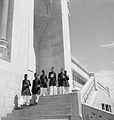Portal:Hyderabad
The Hyderabad Portal
Hyderabad (/ˈhaɪdərəbæd/ HY-dər-ə-bad; ISO: Haidarābād, Telugu: [ˈɦaɪ̯daɾaːbaːd] , Urdu: [ˈɦɛːdəɾaːbaːd]) is the capital and largest city of the Indian state of Telangana. It occupies 650 km2 (250 sq mi) on the Deccan Plateau along the banks of the Musi River, in the northern part of Southern India. With an average altitude of 542 m (1,778 ft), much of Hyderabad is situated on hilly terrain around artificial lakes, including the Hussain Sagar lake, predating the city's founding, in the north of the city centre. According to the 2011 census of India, Hyderabad is the fourth-most populous city in India with a population of 6.9 million residents within the city limits, and has a population of 9.7 million residents in the metropolitan region, making it the sixth-most populous metropolitan area in India. With an output of US$ 95 billion, Hyderabad has the sixth-largest urban economy in India.
Until the 19th century, Hyderabad was known for the pearl industry and was nicknamed the "City of Pearls", and was the only trading centre for Golconda diamonds in the world. Many of the city's historical and traditional bazaars remain open. Hyderabad's central location between the Deccan Plateau and the Western Ghats, and industrialisation throughout the 20th century attracted major Indian research, manufacturing, educational and financial institutions. Since the 1990s, the city has emerged as an Indian hub of pharmaceuticals and biotechnology and information technology. The formation of the special economic zones of Hardware Park and HITEC City, dedicated to information technology, has encouraged leading multinationals to set up operations in Hyderabad. (Full article...)
Selected article -
The Hyderabad State Forces were the armed forces of the princely state of Hyderabad. People from both India and abroad were recruited into the Forces. Among these groups were Arab nationals like Chaush and African nationals like Siddis who now stay in Barkas and A. C. Guards areas of Hyderabad respectively. The Hyderabad cavalry was chiefly composed of Muslim castes such as Mughals, Pathans, Syeds, Sheikhs and Balochs. They were principally recruited from the Deccan, but Delhi, Lucknow, Shahjahanpur, Sindh and Balochistan also supplied recruits to bolster ranks. These non-indigenous soldiers were known as the "Rohollas". The Hindus made a very small portion of the cavalry. The Nizam of Hyderabad also had about 1200 Sikh guards. Other battalions within the army were referred to with the suffix "-walas". Some troops were also supplied by the Europeans for the security of the Nizam. (Full article...)
General images
Related portals
WikiProjects

- This article is within the scope of WikiProject India.
- This article is maintained by the WikiProject Indian cities workgroup.
Selected picture -

Did you know (auto-generated)

- ... that besides official retreats in Hyderabad and in Shimla, the president of India also has one in Dehradun?
Categories
Topics
Wikimedia
The following Wikimedia Foundation sister projects provide more on this subject:
-
Commons
Free media repository -
Wikibooks
Free textbooks and manuals -
Wikidata
Free knowledge base -
Wikinews
Free-content news -
Wikiquote
Collection of quotations -
Wikisource
Free-content library -
Wikispecies
Directory of species -
Wikiversity
Free learning tools -
Wikivoyage
Free travel guide -
Wiktionary
Dictionary and thesaurus

























































